Bombardier CRJ200
| CRJ100 / CRJ200 | |
|---|---|
_AN0779703.jpg) | |
| Delta Connection CRJ200 | |
| Role | Regional jet/Business jet |
| National origin | Canada |
| Manufacturer | Bombardier Aerospace |
| First flight | 10 May 1991 |
| Introduction | 1992 (Lufthansa) |
| Status | Out of production, active service |
| Primary users | SkyWest Airlines ExpressJet Endeavor Air Air Wisconsin |
| Produced | 1991–2006 |
| Number built | 1021[1] |
| Unit cost |
US$24–39.7 million (2006) |
| Developed from | Bombardier Challenger 600 |
| Variants | CRJ700/900/1000 |
The Bombardier CRJ100 and CRJ200 (formerly known as the Canadair CRJ100 and CRJ200) are a family of regional airliners designed and manufactured by Bombardier. The CRJ had the distinction of marking Canada's entry into the civil jet industry.[2]
It was based on the Canadair Challenger business jet. An initial effort to produce an enlarged 36-seat version of the aircraft, known as the Challenger 610E, was terminated during 1981. Shortly after Canadair's privatisation and sale to Bombardier, work on a stretched derivative was reinvigorated; during early 1989, the Canadair Regional Jet program was formally launched. On 10 May 1991, the first of three CRJ100 prototypes conducted its maiden flight. The type first entered service during the following year with its launch customer, German airline Lufthansa.
The initial variant, the CRJ100, was soon joined by another model, designated as the CRJ200. It was largely identical to the CRJ100, except for the installation of more efficient turbofan engines, which gave the aircraft lower fuel consumption, increased cruise altitude and cruise speed.[3] During the 1990s, various additional versions and models of the type were developed and put into service. During the late 1990s, a substantially enlarged derivative of the airliner, referred to as the CRJ700, was developed; it was soon joined by the even larger CRJ900 and CRJ1000.[3] During 2006, production of both the CRJ100 and CRJ200 came to an end; the majority of produced airliners have remained in revenue service to date. Additionally, several airlines have modernised their fleets to support extended service.
Development
Origins
The CRJ family has its origins in the design of the earlier Canadair Challenger business jet. During the late 1970s, the relatively wide fuselage of the Challenger, which could comfortably seat a pair of passengers on each side of a central aisle, was observed by some Canadair officials to suggest that it would be somewhat straightforward to produce a stretch of the aircraft for the purpose of accommodating more seats. Accordingly, during 1980, the company publicised its proposal for an expanded model of the aircraft, designated as the Challenger 610E, which would have had seating for an additional 24 passengers.[4] However, such a lengthening did not occur as a result of work on the programme being terminated during the following year.

Despite the cancellation of the 610E, neither the concept or general interest in the development of an enlarged derivative had disappeared. During 1987, the year following Canadair's sale to Bombardier, design studies commenced into options for producing a substantially more ambitious stretched configuration of the Challenger.[5][2] During the spring of 1989, these investigations directly led to the formal launch of the Canadair Regional Jet program; it had been decided to retain the "Canadair" name despite the firm's purchase by Bombardier. The programme was launched with the aim of selling at least 400 aircraft.[5]
The Regional Jet program benefitted from the support of the Canadian government.[2] Reportedly, the break even point for the type was considered to be relatively low amongst its contemporaries; it has been speculated that the bankruptcy and purchase of Learjet by Bombardier during 1990 had allowed for the development costs of the Challenger to be written off, which in turn had the impact of substantially lowering the cost of the Regional Jet program.[5] In addition, the projected operating costs of the budding airliner was lower than some of its turboprop-powered rivals, including the Fokker 50, the ATR-42, and the Bombardier Dash 8-300.[5]
On 10 May 1991, the first of three development aircraft for the initial CRJ100 variant performed its first flight from Montréal–Mirabel International Airport. During the following year, the type was awarded airworthiness certification; on 29 October 1992, initial deliveries to customers occurred later on that year.[3] On 26 July 1993, the first prototype (C-FCRJ) was lost in a spin mishap near the Bombardier test center in Wichita, Kansas.[6][7]
Further development
_-_EC-JEN_-_LEMD_-_200503051641.jpg)
The initial model was followed by the CRJ100 ER subvariant, featuring 20 per cent greater range, and the CRJ100 LR subvariant, which possessed 40 per cent more range than the standard CRJ100. This sub-variant was developed with the purpose of more closely conforming with the requirements of both corporate and executive operators. A cargo door retrofit has been developed for the installation of former passenger-configured aircraft to extend the useful life of early-built CRJ100s.[8]
The CRJ200 is almost identical to the earlier CRJ100 model, except for the adoption of more efficient engines; these new engines have been attributed as having provided the CRJ200 with several improvements in performance, such as lower fuel consumption, as well as an increase in cruise altitude and cruise speed.[3] Bombardier had specifically designed the new model to provide better performance and efficiencies than any of its nearest competitors at that time.[9] There is also a CRJ200 freighter version, designated as the CRJ200 PF (Package Freighter), which was developed in cooperation with Cascade Aerospace on the request of Scandinavian operator West Air Sweden.[10][11]
During 1995, Bombardier embarked on design studies and a detailed market evaluation on the topic of producing a substantially enlarged derivative of the CRJ200.[3] These efforts quickly transitioned into a $450 million program to produce such an aircraft, which was produced as the CRJ700. Many areas of commonality, such as the design of the cockpit, were retained between the CRJ200 and its newer, larger brethren, but various new systems and structures, such as an all-new wing, were incorporated into the design as well.[9][12] Capable of seating up to 70 passengers, the first of these aircraft was delivered during 2001; the CRJ700 was soon joined by the even larger CRJ800 and CRJ900 models.[3]
Design
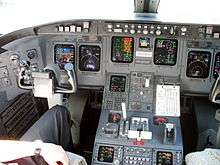
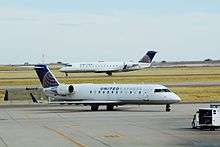
The Bombardier CRJ100 and CRJ200 are a family of jet-propelled regional airliners, based upon the design of the Challenger CL-600 business jet. Roughly, the CL-600 was stretched 5.92 metres (19 feet 5 inches), which was achieved using fuselage plugs fore and aft of the wing, and was matched with the adoption of a reinforced and modified wing, an expanded fuel capacity, improved landing gear to handle the higher weights, and an additional pair of additional emergency exit doors. When installed in a typical seating configuration, the CRJ100 would accommodate 50 passengers; while in a maximum configuration, 52 passengers could be accommodated. It was powered by a pair of General Electric CF34-3A1 turbofan engines, which were capable of generating up to 41.0 kN (4,180 kgp / 9,220 lbf) of thrust. The CRJ100 featured a Collins-built ProLine 4 avionics suite, including a weather radar.
Operational history
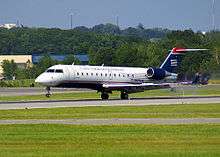
German airline Lufthansa CityLine, a subsidiary of the nations flag carrier operator Lufthansa, served as the launch customer for the CRJ100. Throughout the type's production life, it continued to be a major customer of the CRJ series. During 2001, following Lufthansa's acquisition of 25 per cent of regional airliner Eurowings, the airline ordered 15 CRJ200s with options for 30 more as part of a strategic move towards fleet commonality with Lufthansa Skyline.[13][14]
During the airliner's first 100 days of operational service, the CRJ100 performed a total of 1,237 flights, during which it reportedly achieved a 99 per cent dispatch reliability while its fuel economy was reportedly 8 per cent superior to the originally projected figure.[8] According to aviation author Dean Roberts, the CRJ100 had benefitted greatly from an industry-wide shift towards hub-and-spoke networks in the United States, which had resulted from the Airline Deregulation Act of 1978.[2] Considerable demand across the North American market was experienced by both the CRJ100 and the CRJ200.[2] The smaller size of the regional jets meant than, unlike traditional narrowbody jets, they could be used at the majority of secondary airports and avoid traditional hubs.[9]
Soon after the entry to service of the longer range CRJ200, the model proven to be a commercial success as well. According to aerospace publication Flight International, 1999 was a record year in terms of aircraft deliveries by Bombardier.[15] Writing around this time, authors Bijan Vasigh, Reza Taleghani, and Darryl Jenkins declared that "the CRJ program [is] one of the most successful regional aircraft programs in the world".[9] By the end of 2000, perhaps the most significant operators of the CRJ100 included the American airline Comair, German short-haul operator Lufthansa Cityline, and French regional airline Brit Air; of its CRJ200 sibling, key operators by this time included Delta Connection, SkyWest Airlines, and Independence Air.[16]
During early 1999, Bombardier announced the biggest ever order in the company's history; issued by Northwest Airlines, it involved a firm order for 54 CRJ-200LRs along with options for a further 70 aircraft for $1.3 billion. In response to customer demand, the company stated that it was to increase production at its Montreal assembly line from 75 to 90 aircraft per year before the end of the year.[17] By 2001, a total of 516 airliners were reportedly on order, of which 272 had been delivered.[18] To address the backlog of nearly 250 aircraft, Bombardier worked in increase the rate of production from 9.5 regional jets per month to 12.5 regional jets. The boom in regional jets did not exclusively benefit only the CRJ series; simultaneously, Brazilian manufacturer and rival firm Embraer also worked to increase their output of regional jets.[18]
For a time, the CRJ series was viewed by Bombardier as a means of entering new markets; around the turn of the century, considerable sales focus to the Asia Pacific region was implemented, leading to several sales of regional jets to airlines in nations such as China and Japan.[19][15][20] The company's sales strategy was augmented by the availability of financing from the Canadian government, via which means customers of the CRJ would sometimes partially-finance their purchase.[21] In order to appropriately provide services to the diverse customers for the CRJ series, Bombardier invested in a series of support facilities throughout the world.[22][15][23]
The American operator Delta Connection was a major source of orders for the CRJ200 early on; during April 2000, it was announced that the airline had placed a $10 billion order for 500 CRJs to meet its needs and its subsidiaries, these were a combination of CRJ200s and CRJ700s.[24] According to Flight International, during early 2000, Delta was operating more regional jets than any other North American airline.[25] By June 2003, the airliner operated a fleet of 223 CRJs and was ordering yet more of the type.[26] Delta's influence on the fortunes of the CRJ program was significant, during late 2004, when Bombardier announced an incoming cut in the type's production rate, amongst the reasons given was a delay in anticipated orders for additional CRJ200s.[27] A CRJ200ER delivered in 2003 had a $21 million value.[28]
The American holding company Pinnacle Airlines Corporation operated a fleet of CRJ200s. Outfitted with a 44-seat configuration, designated as the CRJ440, these aircraft had closets in the forward areas of the passenger cabin, though these were later converted to 50 seat airplanes. These modifications were designed to allow operations under their major airline contract "scope clause" which restricted major airlines' connection carriers from operating equipment carrying 50 or more passengers to guard against usurpation of Air Line Pilots Association and Allied Pilots Association pilots' union contract; these scope clauses have been since relaxed when union contracts were re-written between unions and the three remaining U.S. legacy carriers. Similarly, Comair's fleet of 40-seat CRJ200s were sold at a discounted price to discourage Comair from purchasing the less expensive and smaller Embraer 135.
During the middle of the 2000s, Bombardier's commercial aircraft division had incurred persistent operational losses, which motivated figures within management to initiate restructuring and cost-cutting efforts.[27] As such, during 2004, repeated cuts to the production rate of the CRJ100/200 series were announced in conjunction with declining market forecasts, which had the effect of narrowing the division's losses.[29][30][31] The company soon adopted a new market strategy, prioritising the newer and larger CRJ700 and its direct derivatives over other products, such as its turboprop range and the older CRJ100 and CRJ200 models that had spawned them.[32][33] During early 2006, Bombardier terminated its activity on the CRJ program and the production line was closed down; according to Pierre Beaudoin, president and chief operating officer at Bombardier Aerospace, the decision was difficult but necessary for profitability.[34]
While no further CRJ100 or CRJ200 jet liners have been constructed since 2006, over the years since then, various technologies and innovations have been retrofitted onto examples of the type, which have largely remained in commercial service. Some of the operators of the larger versions, such as the CRJ700, have undertaken work to install Wi-Fi capabilities on board the type; however, to date, no airlines operating the CRJ200/100 had chosen to implement an onboard Wi-Fi compatibility.[35]
Reportedly, during the 2010s, various airlines have been typically accelerating the retirement of their fleets of the 50-seat regional jets because of the number of flight cycles they have accumulated, as well as the impact of rising fuel prices that made the CRJ100/200 increasingly uneconomical to operate. As an impact of their retirements, the component values have been decreasing in recent years.[36] Those airlines that have been withdrawing the type have been frequently replacing their CRJs with several more modern airliners, such as the Embraer E-175 and the larger Bombardier CRJ-700/900.
Variants
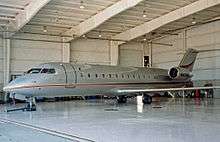
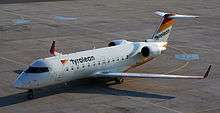
Several models of the CRJ have been produced, ranging in capacity from 40 to 50 passengers. The Regional Jet designations are marketing names and the official designation is CL-600-2B19.
- CRJ100
- The CRJ100 is the original 50-seat version. It is equipped with General Electric CF34-3A1 engines. Operators include Air Georgian and RwandAir, among others.
- CRJ100SF
- Passenger-to-freighter conversion of CRJ100.
- CRJ100SE
- Executive passenger conversion of CRJ100.
- CRJ200
- The CRJ200 is identical to the CRJ100 except for its engines, which were upgraded to the CF34-3B1 model, offering improved efficiency.
- CRJ200PF
- Package freighter version of CRJ200.
- CRJ200LR
- Long range version of CRJ200.
- CRJ200SF
- Passenger-to-freighter conversion of CRJ200.
- CRJ440
- Certified up to 44-seat, this version was designed with fewer seats in order to meet the needs of some major United States airlines.
- Challenger 800/850
- A business jet variant of the CRJ200
- CRJ500
- Proposed 50-seat version with wing and cabin improvements based on the CRJ700/900. Cancelled in 2001.
Operators
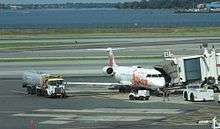
1021 CRJ100/200 have been ordered and delivered : 226 CRJ100s, 709 CRJ200s and 86 CRJ440s.[1] In July 2018, 498 CRJ100/200 were in airline service : 407 in North America, 58 in Europe, 16 in Africa, 16 in Asia Pacific and 1 in the Middle East.[37] Operators with 10 or more are:
- SkyWest Airlines (189)
- Air Wisconsin (65)
- Endeavor Air (42)
- PSA Airlines (35)
- RusLine (17)
- Air Georgian (16)
- Línea Aérea Amaszonas (12) (17 including subsidiaries)
- Jazz Aviation (10)
- Yamal Airlines (10)
Accidents and incidents
- On 16 December 1997, Air Canada Flight 646, a Bombardier CRJ-100, crashed on a go-around at Greater Fredericton Airport in Fredericton, New Brunswick. No fatalities were reported.
- On 22 June 2003, Brit Air Flight 5672 with registration F-GRJS from Nantes to Brest, France, crashed 2.3 miles short and 0.3 miles to the left of the runway when attempting a landing at Brest's airport. The aircraft's captain was the sole fatality.
- On 14 October 2004, Pinnacle Airlines Flight 3701, a Bombardier CRJ-200, crashed on a non revenue, repositioning flight from Little Rock, Arkansas to Minneapolis. The pilots attempted to climb the aircraft to its published service ceiling of 41,000 feet, exceeding the aircraft's capabilities for the existing conditions. This resulted in the flame out and possible core lock of both engines. The aircraft crashed about fifteen minutes later, in sight of the diversion airport, killing both pilots.[38]
- On 21 November 2004, China Eastern Airlines Flight 5210, a Bombardier CRJ-200LR, crashed shortly after takeoff, killing all 53 on board as well as two on the ground.[39]
- On 27 August 2006, Comair Flight 5191, marketed as Delta Connection Flight 5191, a Bombardier CRJ-100ER, crashed during takeoff from the wrong runway at Blue Grass Airport in Lexington, Kentucky. There were 49 fatalities, with only the severely injured first officer surviving.
- On 20 May 2007, an Air Canada Jazz Bombardier CRJ-100 which originated in Moncton, New Brunswick, was substantially damaged when its landing gear collapsed after landing at Toronto-Pearson International Airport, ON (YYZ). There were no injuries to any crew or passengers. Flight AC8911 departed Moncton (YQM) on a domestic flight to Toronto. The aircraft landed on runway 6 right with a 90 degree crosswind from the left, gusting from 13 to 23 knots. The aircraft first contacted the runway in a left-wing-down sideslip. The left main landing gear struck the runway first and the aircraft sustained a sharp lateral side load before bouncing. Once airborne again, the flight and ground spoilers deployed and the aircraft landed hard. Both main landing gear trunnion fittings failed and the landing gear collapsed. The aircraft remained upright, supported by the landing gear struts and wheels. The aircraft slid down the runway and exited via the Delta 3 taxiway, where the passengers deplaned. There was no fire. There were no injuries to the crew; some passengers reported minor injuries as a result of the hard landing.[40]
- On 16 December 2007, Air Wisconsin flight 758A, a Bombardier CRJ-200LR, overran the runway during landing at T. F. Green Airport in Providence, Rhode Island. No injuries or fatalities were reported.[41]
- On 13 February 2008, Belavia Flight 1834, a Bombardier CRJ-100LR, crashed and flipped-over during takeoff at Zvartnots International Airport in Yerevan, Armenia. Most passengers suffered some burns, and four were taken to the hospital. No fatalities were reported.
- On 12 November 2009, RwandAir Flight 205, a Bombardier CRJ-100, crashed into a VIP terminal shortly after an emergency landing at Kigali International Airport, Rwanda; out of the ten passengers and five crew members, one passenger died.
- On 19 January 2010, PSA Airlines Canadair CRJ-200 N246PS overran the runway at Yeager Airport, Charleston, West Virginia following an aborted take-off. The aircraft was stopped by the EMAS at the end of the runway, sustaining minor damage to its undercarriage.[42] The information in the referenced article regarding "substantial" damage was premature and inaccurate. The aircraft was flown away within days of the incident after removal of a damaged landing gear cover.
- On 17 March 2011, Jetlink Express Bombardier CRJ 100, flight JO 752 from Nairobi Jomo Kenyatta International Airport veered off the runway at Kisumu Airport while attempting to land in light rain and misty weather. The aircraft stopped safely a few metres from the shores of Lake Victoria. There were no fatalities.
- On 4 April 2011, a Georgian Airways Canadair CRJ-100ER 4L-GAE operating under an UN mission as flight 834 from Bangoka International Airport, Kisangani, Democratic Republic of the Congo to N'djili Airport missed the runway on landing at Kinshasa. The aircraft subsequently broke into pieces and caught fire. Only one survivor is reported out of 29 passengers and 4 crew. The airport was experiencing torrential rain, thunderstorms and low visibility at the time.[43]
- On 6 June 2011, a SkyWest Airlines Canadair CRJ-200, flight OO 4443 (code share DL 443) from Cincinnati to Milwaukee couldn't extend right main landing gear; however, left main landing gear was extended and locked. After several failed attempts to extend the right main landing and running low on reserved fuel, airplane landed with right main gear up on runway 19R. Emergency service was on scene and no fire broke out. No injuries occurred. Runway was closed for two hours as the result.[44]
- On 2 September 2011, Atlantic Southeast Airlines Flight 5058, operated by Canadair CRJ-200 N875AS landed at Baton Rouge Metropolitan Airport with the left main undercarriage retracted. There were no injuries amongst the 50 passengers and three crew on board.[45]
- On 5 May 2012 an Akbars Aero CRJ-200, flying from St. Petersburg to Astrakhan, Russia, made a forced landing at Voronezh airport, due to cracking of the pilot's windshield.[46]
- On 17 July 2012, a suspended SkyWest employee attempted to steal a CRJ-200 from a Utah airport. Although his security access cards had been de-activated, the employee was able to enter the jet, start it, and attempt to taxi it toward a runway. The jet hit a jetway and a building, plowed into a parking lot and came to rest when its nose gear collapsed. After crashing the plane in the parking lot, the employee shot himself in the head and died at the scene.[47]
- On 29 January 2013, SCAT Airlines Flight 760 crashed 5 km short of Almaty International airport in Kazakhstan near the village of Kyzyltu while attempting to land in bad weather conditions. 16 passengers and 5 crew died.[48]
- On 8 January 2016, West Air Sweden Flight 294 between Oslo (Gardermoen) and Tromsø (Langenes) crashed, after incorrect attitude information was displayed to one pilot,[49] in northern Sweden near Ritsem, Padjelanta National Park.[50] The plane was carrying 4.5 tonnes of mail on behalf of Norway Post. The two crew members died.[51]
Specifications
| Variant | CRJ-100 | CRJ-200 |
|---|---|---|
| Crew | 3–4 : 2 Flight Crew + 1–2 cabin crew | |
| Seating capacity | 50 | |
| Cabin height | 6 ft 1 in / 1.85 m | |
| Cabin width | 8 ft 3 in / 2.53 m | |
| Length | 87 ft 10 in / 26.77 m | |
| Wingspan | 69 ft 7 in / 21.21 m | |
| Height | 20 ft 5 in / 6.22 m | |
| Wing area | 520.4 ft² / 48.35 m²[53] | |
| Fuselage diameter | 8 ft 10 in / 2.69 m | |
| Operating empty | 30,500 lb / 13,835 kg | |
| Max payload | 13,500 lb / 6,124 kg | |
| Max fuel | 2,135 US Gal / 8,081 L 14,305 lb (6,489 kg) | |
| Max Take Off | ER : 51,000 lb / 23,133 kg LR : 53,000 lb / 24,041 kg | |
| Engines (2x) | GE CF34-3A1 | GE CF34-3B1 |
| Takeoff thrust (2x) | 8,729 lbf / 38.84 kN[53] | |
| 50 pax range | ER : 1,305 nm / 2,417 km LR : 1,650 nm / 3,056 km[54] |
ER : 1,345 nm / 2,491 km LR: 1,700 nm /3,148 km[53] |
| Normal cruise | M0.74 : 785 km/h (424 kn)[54] | |
| High-speed cruise | M0.81 : 860 km/h (460 kn)[54] | |
| Service ceiling | 41,000 ft / 12,496 m[53] | |
| Takeoff (SL, ISA, MTOW) | ER : 5,800 ft / 1,770 m LR: 6,290 ft / 1,920 m[54][53] | |
| Landing (SL, MLW) | 4,850 ft / 1,480 m[54][53] | |
See also
Related development
Aircraft of comparable role, configuration and era
Related lists
References
Citations
- 1 2 "CRJ Series Program Status Report" (PDF). Bombardier. 30 June 2015.
- 1 2 3 4 5 Roberts 2017, p. 109.
- 1 2 3 4 5 6 Eriksson and Steenhuis 2015, p. 58.
- ↑ "Canadair Challenger." Flight International, 21 June 1980. p. 1437.
- 1 2 3 4 Eriksson and Steenhuis 2015, p. 57.
- ↑ "The History of Canadair Regional Jet MSN 7001". Winglets. Retrieved 20 November 2014.
- ↑ Harro Ranter (26 July 1993). "ASN Aircraft accident Canadair CL-600-2B19 Regional Jet CRJ-100 C-FCRJ Byers, KS". Aviation-safety.net. Retrieved 20 November 2014.
- 1 2 Bombardier (20 June 2017). "The Rise and Rise of Regional Aircraft". FlightGlobal.
- 1 2 3 4 Vasigh, Taleghani and Jenkins 2012, p. 90.
- ↑ Shannon, Darren and David Kaminski-Morrow (8 August 2006). "West Air launches cargo CRJ as Cascade aims for kit deal". Flightglobal.
- ↑ "Bombardier – CRJ – 200". AirTeamImages.com. Retrieved 20 November 2014.
- ↑ Doyle, Andrew., Emma Kelly, and Paul Lewis. "Regional risk-taking." Flight International, 19 September 2000.
- ↑ "Eurowings to land Bombardier regionals." Flight International, 8 May 2001.
- ↑ Doyle, Andrew. "Lufthansa closes in on regionals and A330-300s." Flight International, 30 July 2002.
- 1 2 3 Martin, Mark. "Bombardier forges ahead in Asia-Pacific." Flight International, 23 February 2000.
- ↑ Vasigh, Taleghani and Jenkins 2012, p. 88.
- ↑ Lewis, Paul. "Bombardier increases production." Flight International, 24 February 1999.
- 1 2 Hecker and Martin 2001, p. 47.
- ↑ "Bombardier CRJs sold to Shanghai Airlines." Flight International, 22 February 2000.
- ↑ "Japan Airlines firms up options." Flight International, 1 December 2000.
- ↑ Dunn, Brian. "Government loan may help Bombardier win $3bn order ." Flight International, 16 January 2001.
- ↑ Endres, Gunter. "Jet Impact." Flight International, 1 May 2001.
- ↑ Warwick, Graham. "Bombardier readies for expansion of service arm." Flight International, 16 April 2002.
- ↑ Warwick, Graham. "Delta signs massive CRJ deal." Flight International, 4 April 2000.
- ↑ Jasper, Chris. "Delta pioneers regional jet revolution." Flight International, 6 June 2000.
- ↑ Lewis, Paul. "Delta to confirm CRJ200 orders." Flight International, 10 June 2003.
- 1 2 "Bombardier cuts CRJ output." Flight International, 12 October 2004.
- ↑ Aircraft Value News (May 14, 2018). "CRJ900 New Pricing Continues to Undermine Used Values".
- ↑ "Second cut in CRJ200 production reflects swing to larger aircraft." Flight International, 7 December 2004.
- ↑ Warwick, Graham. "Business jets help Bombardier to break even." Flight International, 31 August 2004.
- ↑ Warwick, Graham. "Bombardier cuts annual CRJ200 production to 18 aircraft." Flight International, 25 August 2005.
- ↑ Kirby, Mary. "US airline consolidation could spark interest in 70-plus seat jets at regional and mainline carriers." Flight International, 29 April 2008.
- ↑ Shannon, Darren. "Bombardier banks on bigger jets." Flight International, 5 April 2005.
- ↑ "CRJ200 production halted." Flight International, 1 November 2005.
- ↑ "Hemisphere Magazine". December 2016 – via magazine.
- ↑ Compart, Andrew. "Young at Part." Aviation Week and Space Technology, 15 April 2013. pp. 44–46.
- ↑ "World Airline Census 2018". Flightglobal.com. Retrieved 2018-08-26.
- ↑ Warwick, Graham. "Pinnacle CRJ engines shut down after 41,000ft stall." Flight International, 16 November 2004.
- ↑ Francis, Leithen and David Learmount. "Chinese CRJs grounded." Flight International, 30 November 2004.
- ↑ Harro Ranter (20 May 2007). "ASN Aircraft accident Canadair CL-600-2B19 Regional Jet CRJ-100ER C-FRIL Toronto-Pearson International Airport, ON (YYZ)". Aviation-safety.net. Retrieved 20 November 2014.
- ↑ "Probable Cause, DCA08FA018". Ntsb.gov. Retrieved 20 November 2014.
- ↑ "Accident: PSA Airlines CRJ2 at Charleston on Jan 19th 2010, overran runway on takeoff". The Aviation Herald. Retrieved 20 January 2010.
- ↑ "Georgian Airways CRJ1 at Kinshasa on Apr 4th 2011, missed the runway and broke up". The Aviation herald. Retrieved 5 April 2011.
- ↑ "Airport closed after emergency landing". Milwaukee Journal Sentinel. Jun 6, 2011. Retrieved 14 June 2011.
- ↑ Hradecky, Simon. "Accident: Atlantic Southeast CRJ2 at Baton Rouge on Sep 1st 2011, left main gear up landing". The Aviation Herald. Retrieved 2 September 2011.
- ↑ "-". Interfax.ru. Retrieved 20 November 2014.
- ↑ "Man takes control of SkyWest jet at Utah airport". USATODAY.COM. Retrieved 20 November 2014.
- ↑ "21 Dead in Kazakhstan Plane Crash". The Gazette of Central Asia. Satrapia. 29 January 2013.
- ↑ "Air Sweden CRJ200 Freighter Downed: Failed IRU called key to upset". Aviation Week. Retrieved 2017-03-01.
- ↑ "FlightRadar24 report on PT294 crash". FlightRadar24. Retrieved 2016-01-08.
- ↑ "Police source to SVT: -The plane crashed straight to the ground". Retrieved 2016-01-08.
- ↑ "CRJ airport planning manual" (PDF). Bombardier. Jan 10, 2016.
- 1 2 3 4 5 6 "CRJ200 Fact sheet" (PDF). Bombardier. June 2006.
- 1 2 3 4 5 "CRJ Specifications". Bombardier.
The initial version of this article was based on a public domain article from Greg Goebel's Vectorsite.
Bibliography
- Eriksson, Sören and Harm-Jan Steenhuis. The Global Commercial Aviation Industry. Routledge, 2015. ISBN 1-1366-7239-7.
- Hecker, Jayetta Z. and Steven C. Martin. Aviation Competition: Regional Jet Service Yet to Reach Many Small Communities. DIANE Publishing, 2001. ISBN 0-7567-1372-2
- Jackson, Paul. Jane's All The World's Aircraft 2003–2004. Coulsdon, UK: Jane's Information Group, 2003. ISBN 0-7106-2537-5.
- Roberts, Dean C. Entering the Civil Aircraft Industry. Dog Ear Publishing, 2017. ISBN 1-4575-5241-8.
- Vasigh, Bijan., Reza Taleghani and Darryl Jenkins. Aircraft Finance: Strategies for Managing Capital Costs in a Turbulent Industry. J. Ross Publishing, 2012. ISBN 1-6042-7071-3
External links
| Wikimedia Commons has media related to CRJ200. |
- Official website
- "Canadair regional jet airport planning manual" (PDF). Bombardier. Jan 2016.
- Kieran Daly (1 May 1991). "Upmarket regional". Flight International. p. 39.